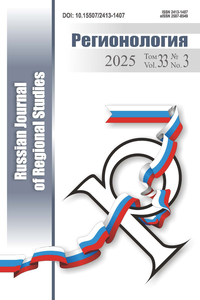A. M. Nosonov. Formation of Innovative Territorial Clusters in the Regions of Russia
UDК 332.1(470+571)
doi: 10.15507/2413-1407.124.031.202303.498-513
Abstract
Introduction. The modern development of Russia is based on the priority development of high-tech industries and the corresponding infrastructure as prerequisites for achieving technical and technological leadership in the global economy. The innovative development of the country largely depends on the success of scientific and technological policy at the regional level. The purpose of the study is to analyze the spatial regularities of the functioning of innovative territorial clusters to justify promising directions of state cluster policy.
Materials and Methods. The study was carried out on the basis of official statistical information of the Federal State Statistics Service, information and analytical reports of the Association of Clusters, Technoparks and Special Economic Zones of Russia, official ratings of innovative development of regions, legislative acts of the federal and regional levels. Based on geo-information technologies, a series of analytical maps have been created that reflect and visualize various aspects of the functioning of innovative territorial clusters in the context of all regions of the Russian Federation.
Results. Spatial patterns of the formation of innovative territorial clusters in the regions of Russia have been identified. It is noted that the implementation of the cluster policy contributes to a more rational use of federal budget funds by determining priority investment areas and establishing on this basis the recipients of state support in the cluster with the greatest potential in the context of limited financial resources. This is especially promising when justifying the stimulation of new high-tech industries and enterprises. The patterns of functioning and development trends of innovative territorial clusters are identified. Promising directions for improving Russia’s cluster policy are formulated.
Discussion and Conclusion. The author considers that the main purpose of the emerging innovative territorial clusters is the saturation of the domestic market with high-tech goods, services and technologies to achieve the technological independence of the country. The results of the study can be used by organizations and decision makers to substantiate ways to improve cluster policy in the regions of the country.
Keywords: innovative territorial cluster, geo-information technologies, infrastructure, high-tech products, clustering factors
Conflict of interests. The author declares that there is no conflict of interest.
For citation: Nosonov A.M. Formation of Innovative Territorial Clusters in the Regions of Russia. Russian Journal of Regional Studies. 2023;31(3):498–513. https://doi.org/10.15507/2413-1407.124.031.202303.498-513
REFERENCES
1. Barinova V.A., Maltseva A.A., Sorokina A.V., Eremkin V.A. Approaches to Assessing the Adequacy and Efficiency of the Innovation Infrastructure Facilities in Russia. Innovations. 2014;(3):42–51. Available at: https://maginnov.ru/ru/zhurnal/arhiv/2014/innovacii-n3-2014/podhody-k-ocenke-dostatochnosti-i-effektivnosti-funkcionirovaniya-obektov-innovacionnoj-infrastruktury-v-rossii (accessed 09.02.2023). (In Russ., abstract in Eng.)
2. Makar S.V., Nosonov A.M. Assessment and Spatial Regularities of the Innovative Activity Development in the Regions of Russia. Economics, Taxes & Law. 2017;10(4):96–106. Available at: http://www.fa.ru/org/div/edition/enp/journals/2017 №4.pdf (accessed 09.02.2023). (In Russ., abstract in Eng.)
3. Koroleva L.P., Kandrashkina M.A. [Innovation Infrastructure: Essence and Tendencies of Development in the Republic of Mordovia]. Sistemnoye upravleniye. 2014;(3). (In Russ.)
4. Nosonov A.M. Productive and Technological Innovation Infrastructure of the Regions of Russia. Russian Journal of Regional Studies. 2019;27(3):436–460. (In Russ., abstract in Eng.) https://doi.org/10.15507/2413-1407.107.027.201903.436-460
5. Terebova S.V. Innovation Infrastructure in the Region: Problems and Directions of Development. Economic and Social Changes: Facts, Trends, Forecast. 2014;(6):199–212. (In Russ., abstract in Eng.) https://doi.org/10.15838/esc/2014.6.36.15
6. Hasan S., Klaiber H.A., Sheldon I. The Impact of Science Parks on Small- and Medium-Sized Enterprises Productivity Distributions: The Case of Taiwan and South Korea. Small Business Economics. 2018;54:1–19. https://doi.org/10.1007/s11187-018-0083-8
7. Miguelez E., Moreno R. Knowledge Flows and the Absorptive Capacity of Regions // Research Policy. 2015;44(4):833–848. https://doi.org/10.1016/j.respol.2015.01.016
8. Moreno R., Paci R., Usai S. Innovation Clusters in the European Regions. European Planning Studies. 2006;14(9):1235–1263. https://doi.org/10.1080/09654310600933330
9. Cooke P. Biotechnology Clusters as Regional, Sectoral Innovation Systems. International Regional Science Review. 2002;25(1):8–37. https://doi.org/10.1177/016001760202500102
10. Martin R., Florida R., Pogue M., Mellander C. Creativity, Clusters and the Competitive Advantage of Cities. Competitiveness Review. 2015;25(5):482–496. https://doi.org/10.1108/CR-07-2015-0069
11. Scholl T., Brenner T. Detecting Spatial Clustering Using a Firm-Level Cluster Index. Regional Studies. 2016;50(6):1054–1068. https://doi.org/10.1080/00343404.2014.958456
12. Audretsch D.B., Heger D., Veith T. Infrastructure and Entrepreneurship. Small Business Economics. 2015;44(2):219–230. https://doi.org/10.1007/s11187-014-9600-6
13. Romer P.M. Mathiness in the Theory of Economic Growth. American Economic Review. 2015;105(5):89–93. https://doi.org/10.1257/aer.p20151066
14. Scranton P. Infrastructure: Reappraisal and Reorientation. In: Scranton P. Enterprise, Organization and Technology in China. Palgrave Macmillan, Cham; 2019. p. 199–230. https://doi.org/10.1007/978-3-030-00398-2_7
15. Sunny S.A., Shu C. Investments, Incentives, and Innovation: Geographical Clustering Dynamics as Drivers of Sustainable Entrepreneurship. Small Business Economics. 2019;52(4):905–927. https://doi.org/10.1007/s11187-017-9941-z
16. Kutsenko E.S., Abashkin V.L., Fiyaksel V.A., Islankina E.A. A Decade of Cluster Policy in Russia: A Comparative in Outlook. Innovations. 2017;(12):46–58. Available at: https://publications.hse.ru/pubs/share/direct/214022951.pdf (accessed 09.02.2023). (In Russ., abstract in Eng.)
17. Tassey G. Modeling and Measuring the Economic Roles of Technology Infrastructure. Economics of Innovation and New Technology. 2008;17(7-8):617–631. https://doi.org/10.1080/10438590701785439
18. Caiazza R., Richardson A., Audretsch D.J. Knowledge Effects on Competitiveness: From Firms to Regional Advantage. The Journal of Technology Transfer. 2015;40(6):899–909. https://doi.org/10.1007/s10961-015-9425-8
19. Abashkin V.L., Boyarov A.D., Kutsenko E.S. Cluster Policy in Russia: From Theory to Practice. Foresight. 2012;6(3):16–27. (In Russ., abstract in Eng.) https://doi.org/10.17323/1995-459X.2012.3.16.27
20. Nosonov A.M., Saraikina S.V. Territorial Innovation Clusters as a Promising Component of Russia’s Innovation Infrastructure. Geopolitics and Ecogeodynamics of Regions. 2022;8(3):208–216. Available at: http://geopolitika.cfuv.ru/территориальные-инновационные-класт/ (accessed 09.02.2023). (In Russ., abstract in Eng.)
Submitted 27.02.2023; revised 29.03.2023; accepted 11.04.2023.
About the author:
Arthur M. Nosonov, Dr. Sci. (Geogr.), Professor, Department of Physical and Socio-Economic Geography, National Research Mordovia State University (68/1 Bolshevistskaya St., Saransk 430005, Russian Federation), ORCID: https://orcid.org/0000-0003-4719-0166, Researcher ID: S-1126-2016, Scopus ID: 57190430793, artno@mail.ru
The author has read and approved the final version of the manuscript.

All the materials of the "REGIONOLOGY" journal are available under Creative Commons «Attribution» 4.0
















